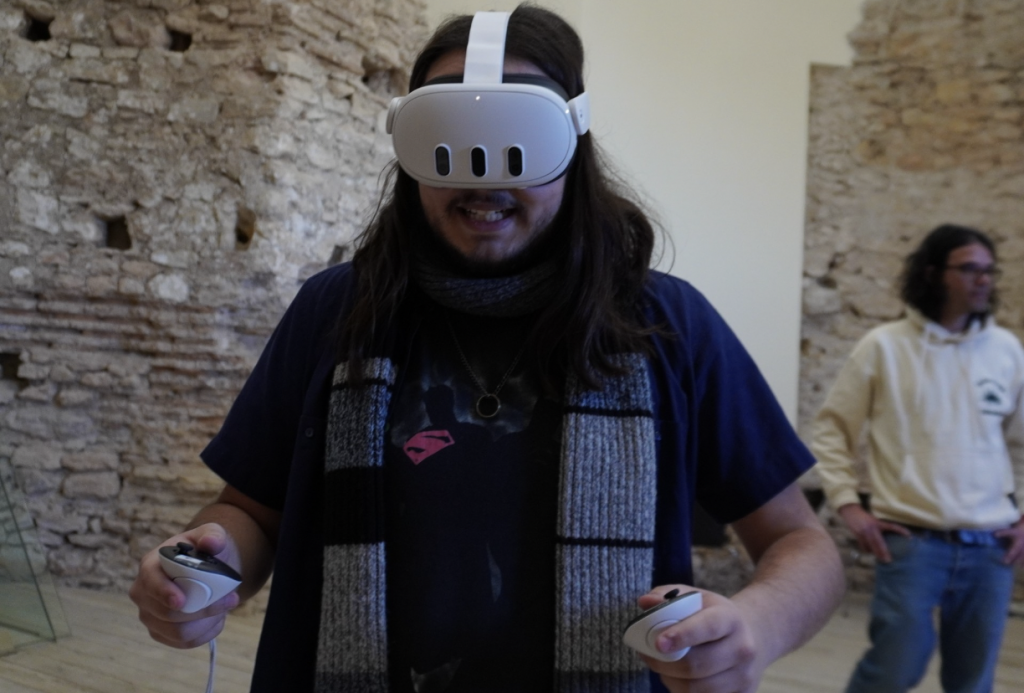Press notes 13/03/2024
Art History and Archaeology students explore 3D technology to disseminate cultural heritage
During the second edition of the Digital Twins conference they focused on techniques such as photogrammetry, virtual reality and storytelling, and analysed their role in the preservation and dissemination of heritage

During the second edition of the Digital Twins conference they focused on techniques such as photogrammetry, virtual reality and storytelling, and analysed their role in the preservation and dissemination of heritage
The Universitat Rovira i Virgili is leading a change in the world of research and teaching by digitizing cultural heritage in the humanities. To do so, it provides students on the bachelor’s degrees in History and History of Art and Archaeology with 3D technology applications so that they have new professional opportunities. These students already work with 3D digitization in the classrooms, and continue their training in these new methodologies.
On 6 and 7 March the University organised the second edition of the Digital Twins conference, in conjunction with the National Archaeological Museum of Tarragona (MNAT) and the Giravolt project of the General Directorate of Cultural Heritage of the Catalan Government and with the collaboration of the Catalan Institute of Classical Archaeology (ICAC) and the CRAI of the URV. In this edition, around forty students of History of Art and Archaeology from the URV explored the application of 3D technology such as photogrammetry or virtual reality to cultural heritage, and analysed its role in the preservation and dissemination of heritage through various theoretical and practical workshops. The conference took place at the Necropolis and the Centcelles Archaeological Ensemble, at the MNAT.

Fundamental tools for disseminating heritage
According to Ignacio Fiz, a lecturer in the Department of History and Art History at the URV, these workshops give students an understanding of how to use 3D tools to create digital twins and safeguard heritage. These twins, he explains, are faithful copies of buildings and immovable heritage that are produced with techniques such as photogrammetry, which creates 3D models from photographs. With this procedure, the students have been able to digitize elements of the archaeological heritage of Tarragona on display at the MNAT and, using tools such as storytelling, they have learned to make the pieces attractive to those interested. In fact, according to Diana Gorostidi, a lecturer in the URV’s Department of Catalan Studies and a researcher at the Catalan Institute of Classical Archaeology, these workshops aim to focus attention on certain parts of the archaeological heritage of Tarragona and how they can be explained to the general public. In this respect, she explains that the students have applied these technologies to monuments from ancient Tàrraco to learn how to use the social networks to bring them to life.
Vanina Hofman, a lecturer in the Department of History and Art History, adds that the workshops allow students to experiment with 3D technologies that are not being used at university, but which are being used in the professional world. More specifically, they have experimented with such new tools as the laser scanner and virtual reality, and applications such as Sketchfab for storytelling. In this respect, Fiz says that the workshops are fundamental if “students are to understand how a laser scanner or the photogrammetry process works and also how to activate 3D objects and make society aware of them”.

Technology and teaching
It is not the first time that URV students have worked with 3D technology. According to Fiz, the bachelor’s degrees in History, History of Art and Archaeology first started to use the digital humanities as a research methodology in the academic year 2019-20 to “prepare students for career opportunities in interdisciplinary teams”.
As a result of this experiential learning, “students can see that the contents of the course can be applied in a wide range of situations”, adds Gorostidi. All this is taught in two subjects, which shows the interdisciplinary nature of the courses, and “this is very important for us”, she explains. Finally, she adds that master’s and doctoral students who are being trained in these transfer techniques have joined the teaching team.

Dalmau Díaz, a student of Art History and Archaeology at the URV, claims that these techniques are of the utmost importance in both the academic field, to understand the piece in greater depth, and in terms of communication. In this regard, he points out that “virtual reality glasses or the digitization not only make a monument much more attractive to the general public, but also more accessible”. Finally, he considers that the use of the new technologies in the humanities to be positive because “the archaeologists of the future will end up working with these technologies on a daily basis, and it is essential to learn how to use them and understand what they mean to us”, he explains.
In fact, according to Fiz, the Department wants students to be familiar with these technologies so that when they start working in interdisciplinary groups, they will understand the language and technologies that are being used in the professional world. “Some will have this profile while others, who are more technologically minded, will be able to use their understanding to exploit these techniques”, he concludes.
